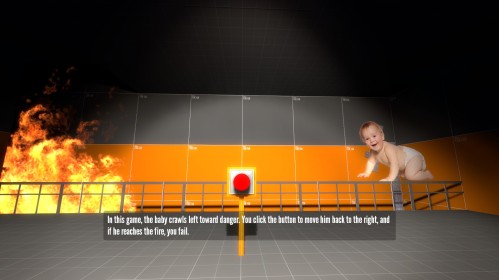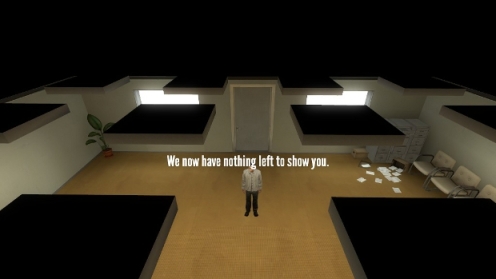
An indie game by the small developer Galactic Cafe, “The Stanley Parable” is about a man named Stanley, a simple office worker who enjoys nothing more than pressing the buttons he has been told to press every day. Then, one day, he leaves his workspace and finds his office building mysteriously empty. All the while, his exploration is given narration and snarky commentary by a mysterious voice.
The plot and story is in some ways extraordinarily simple, and in other ways complicated. It is as much, if not more, a thought experiment than an actual game. The game explores the power and variance that comes from the power of choice, and how much difference can come from the simple act of choosing which door to enter.

“Stanley chose the door on his left.”
 Theoretically, the game’s simplicity opens it up to anyone who can wrap their head around the simple mechanics of movement that is commonplace in first-person games. However, the mind-bending subject matter is primarily a commentary on choice in games, and what is possible even within the constraints of a simple game. This means it might not mean as much to someone who doesn’t play many games.
Theoretically, the game’s simplicity opens it up to anyone who can wrap their head around the simple mechanics of movement that is commonplace in first-person games. However, the mind-bending subject matter is primarily a commentary on choice in games, and what is possible even within the constraints of a simple game. This means it might not mean as much to someone who doesn’t play many games.
However, the game is simultaneously aimed at people who enjoy the thought experiment aspect of the experience. This might be interesting even to someone with no experience with games whatsoever, but it is a very specific sort of interest, so I imagine that audience is small. There is no real action to speak of, so if the player isn’t interested in the ideas it will be a dreadfully boring experience for them. Finally, to get the full experience of the game’s ideas it requires multiple playthroughs – as many as eighteen to get every ending.
So this game is ideally for gamers who prefer idea-driven narratives, little action, and have completionist compulsive tendencies. Let’s just say it’s a niche audience.

“The Stanley Parable” is an interesting idea, and it has some insightful things to say about game narratives and choice in games. The narrator is a lot of fun to listen to, and the twists and turns some of the pathways take through the game can be fascinating. That said, the gameplay is dull, and a short playtime per pathway can’t save it from growing boring after a few times through, especially if you are unlucky enough to hit the most boring story paths your first few times through. This is especially bad news when the game only really comes into its own after the player is exposed to the vast majority of the stories that are told in “The Stanley Parable”’s framework. If the player doesn’t see the majority of the game, the time spent isn’t really worth it.
It may be a niche game with some flaws, but it is hard to hold that against it when it has such interesting ideas. Ultimately I think it’d be worth taking a look if you find it in…

If you want to know more about my ratings, check out what each rating means HERE.

I wasn’t kidding when I said the game play was dull. The player basically just walks around and almost never clicks on things. Choices are made primarily based on where the player decides to go or not go. Do you go through this door or that one? Do you walk off this ledge? Do you just stand still? Occasionally you can click on something, like unplugging a phone, but that’s it. Obviously, running and gunning doesn’t work for the purpose and narrative but it’s still disappointing that there isn’t more to do.

The environments are also dull, and generally not exciting to explore except when the narrative goes seriously weird. Mostly it’s just blank walls and basic office work spaces and architecture. I will say that this helps the moments where things get weird feel more impactful than they would if the environment was already full and engaging.

The best part of the game is the ever-present narrator who has some fun snarky things to say. His personality and character changes based on which playthrough you are in, and it is interesting to hear him change, depending on the playthrough, from angry, to confused, to whiny, to disappointed. If it weren’t for the narrator the game just wouldn’t be worth it.
Even with the narrator, I found it hard to play through it more than a few times without being bored out of my mind. Honestly, playing through it a couple of times, then watching the rest of the endings on youtube might be the most efficient way of seeing all the game has to offer. That was the only way I could see all of the endings myself.

That being said, the game is very short. Even the longest play-through won’t go more than a half hour, so trying to play through a majority of them isn’t too much of a time sink compared to other games. I could see someone playing through the game by trying one different playthrough during a break, or before doing something else, just sliding it into a half-hour block somewhere each day. In fact, that might be the optimal way to play.
Conclusion and Star Rating:
“The Stanley Parable” is a game worth taking a look at for its ideas and for the interesting narrator. These things will stick around long after you’ve played the game. But I wouldn’t call the actual act of playing the game very enjoyable. It almost makes for a better YouTube watch than a game. Still, in the end, I would rate “The Stanley Parable” as a solidly “Good” game.

Three out of Five Stars

The “save the baby” ending is hilarious, but I had no idea there was actually a different ending than simply letting the baby burn. It’s crazy that anyone would sit there long enough to get that ending though. The YouTube video I watched said it took something like four hours of sitting there clicking. I can’t think of anything more mind-numbing.

I suppose I could explore each ending, but honestly, I think that’d take forever. Some of the endings that stuck out in my head, however, were primarily the ones that revealed the world behind the curtain so to speak, or completely broke the rules of reality. The ones where the player commits some form of self-destruction really stuck with me, such as jumping off of the ledge several times to commit suicide. The conversation the narrator has there is fascinating and existential. Also, the ending where Stanley dies in the street and is found by another person was an interesting commentary on the way other people look at us from the outside, and remain oblivious.

I think the ending that I go back and think about the most, however, is actually the one where you find yourself walking above the ceiling in one of the rooms, looking down on your body while the narrator talks to your still body in concern. It was the most surreal moment for me.

Have you guys played “The Stanley Parable?” What did you think? What was your favorite ending? Please feel free to comment below!
